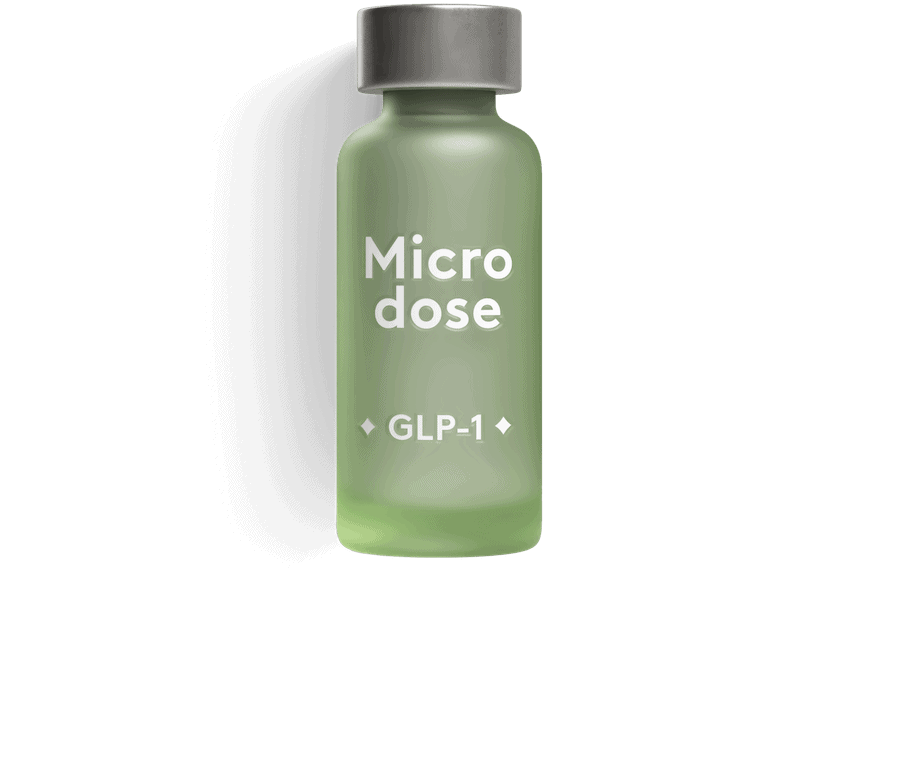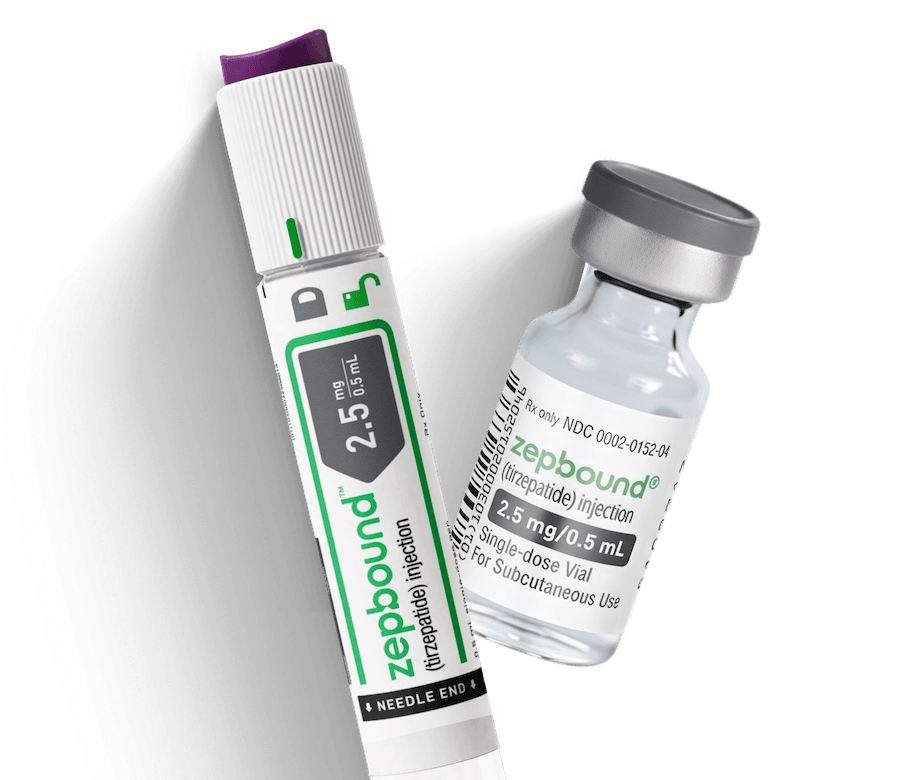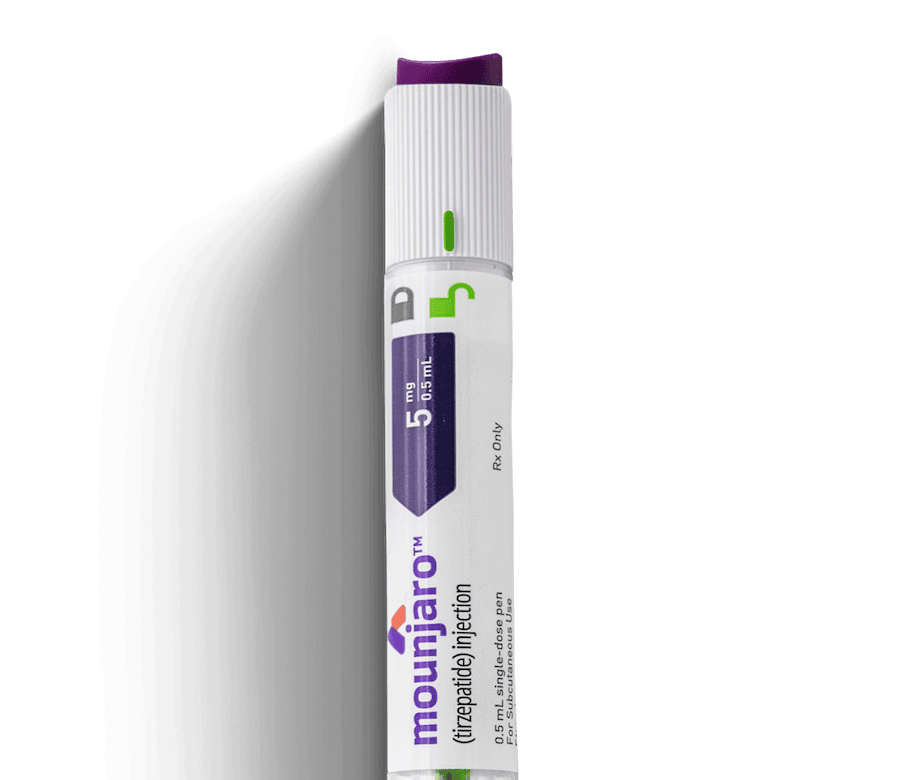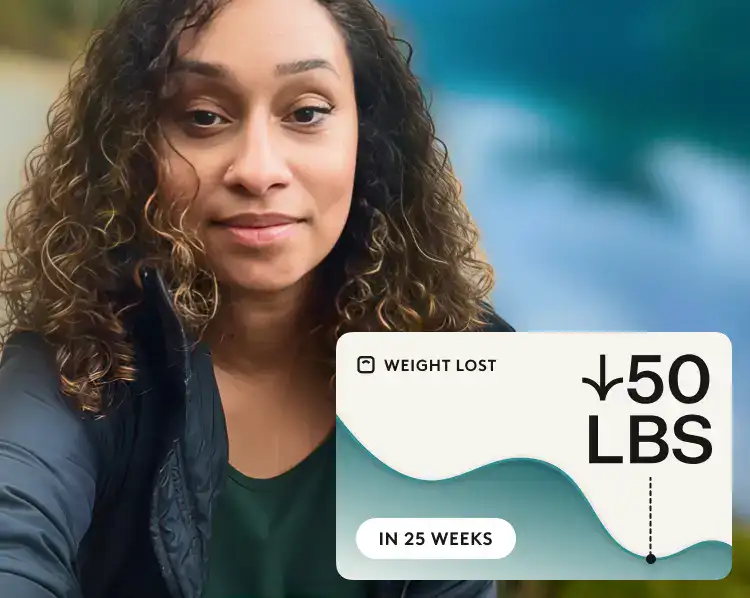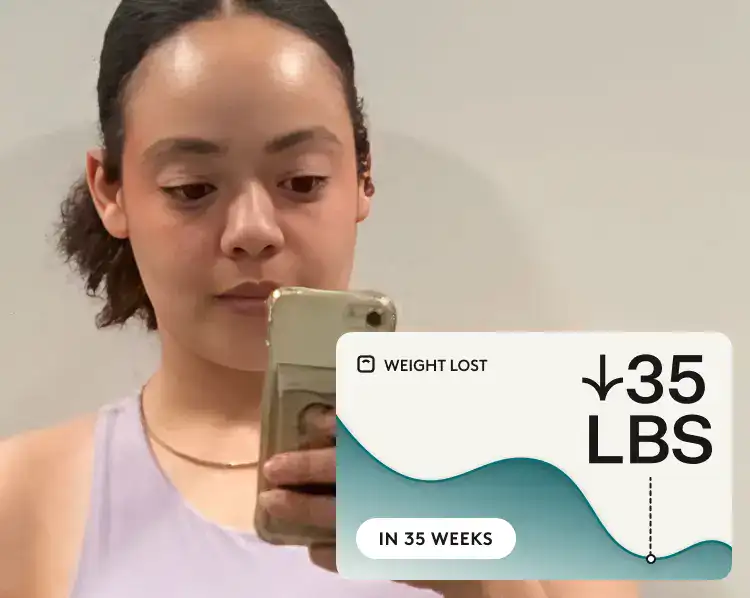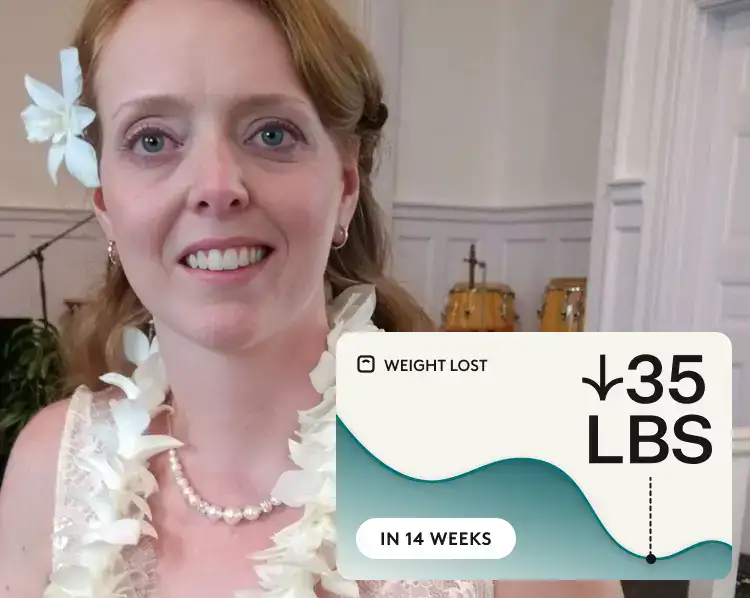What you’ll learn:
- Contrave® is an FDA-approved weight loss pill that combines two medications to help reduce hunger and cravings by targeting brain chemistry.
- The dose gradually increases over four weeks to help your body adjust and limit side effects, while losing steady weight.
- On average, people lose about 12% of their starting body weight after a year of using Contrave® alongside healthy habits like balanced eating and exercise.
When you hear about weight loss medications, your mind might jump straight to injectable GLP-1s. Wegovy® and Zepbound® are FDA-approved for weight loss, and Ozempic® and Mounjaro® are popular off-label solutions. But there are other effective options out there. One to think about is Contrave®, an FDA-approved weight loss pill that brings together two medications, naltrexone and bupropion, to help regulate hunger signals in your brain. This unique combo can help reduce cravings, making it easier to stick with your long-term weight goals.
Contrave was approved in 2014 for weight management in people who have a BMI of 30 or over or 27 or over with a weight-related condition, like high blood pressure or high cholesterol. It’s a good alternative for people looking for a different path to weight loss beyond GLP-1s.
To get the most out of Contrave® and help your body adjust, the dosing is adjusted gradually over time to reduce side effects while still getting effective results.
Let’s walk through exactly what to expect as you and your doctor work together to find your “just right” dose for weight loss. We’ll also discuss potential side effects and important safety information that you’ll need to know before starting the medication.
How Contrave® works
Unlike GLP-1 medications that mimic hormones to slow digestion and signal fullness, Contrave® takes a different approach by working directly with your brain’s chemistry. It’s a combination of two medications, naltrexone and bupropion, each playing a specific role in managing hunger and cravings.
- Naltrexone helps to reduce the “reward” you get from eating certain foods, like those high in sugar and fat. Think of it as dampening the pleasure signals that can lead to overeating or strong cravings, especially for emotional eaters.
- Bupropion, an antidepressant also used to help people quit smoking, affects neurotransmitters like dopamine and norepinephrine. This can help reduce appetite and may even boost your metabolism slightly, making you feel more in control around food.
Together, these two ingredients target key areas in your brain, including the hypothalamus (your appetite control center) and the mesolimbic reward system, which is involved in cravings and the feeling of pleasure from eating.
This dual action helps you feel less hungry and have fewer intense cravings, which can be helpful when you’re working to make healthier food choices.
How Contrave® dosing for weight loss works
When you start Contrave®, you won’t jump straight to the full dose. Instead, your provider will help you ease into it. This gradual plan gives your body time to adjust and helps keep common side effects, like nausea or stomach pain, as mild as possible.
- Starting dose: For the first week, you’ll usually take one tablet in the morning each day. Each tablet combines 8 mg of naltrexone and 90 mg of bupropion, the two ingredients that work together to help manage cravings.
- Dose escalation schedule: Most people follow a four-week ramp-up plan:
- Week 1: One tablet in the morning.
- Week 2: One tablet in the morning and one in the evening.
- Week 3: Two tablets in the morning and one in the evening.
- Week 4 and beyond: Two tablets in the morning and two in the evening (a total of 32 mg naltrexone / 360 mg bupropion per day).
- Maintenance dose: Two tablets twice a day is the typical maintenance dose for ongoing weight loss support.
- Maximum dose: The highest daily dose for Contrave® is four tablets total, split into two in the morning and two in the evening.
Your provider may adjust how fast your daily dose increases if you’re having any side effects.
How much weight can I expect to lose with Contrave®?
Contrave® is designed to help you lose weight gradually and safely. While results vary, here’s what clinical trials have shown at key points during treatment,
- Week 4: On average, people lost about 3% of their starting body weight in the first month.
- Week 16: By four months, people lost about 8% of their starting weight on average. This is also an important assessment period. If you haven’t lost at least 5% at this point, your doctor may recommend stopping Contrave® and exploring other options.
- Week 56: After about a year of taking Contrave® with healthy habits, people lost an average of 12% of their starting body weight.
Rx weight loss, the right way, with Noom
Get access to prescription weight loss medication with Noom.What influences your dose path with Contrave®?
Your healthcare provider considers a few important factors when deciding if you should continue, adjust, or stop Contrave®:
- How you feel on the medication: The typical maintenance dose is two tablets twice a day, starting around week 4. If side effects like nausea, headache, or trouble sleeping are hard to handle, your provider may slow down the increase or suggest ways to make it easier.
- Your weight loss progress: Your provider will check in on your results after you’ve been on the full dose for a few months. If you’re not seeing meaningful weight loss by then, they may suggest trying a different plan that could work better for you.
- Your overall health: Conditions like high blood pressure or a history of seizures can affect whether Contrave® is right for you. Your provider will make sure it’s safe and may adjust or monitor your dose more closely.
- Your age and sensitivity: If you’re 65 or older, your provider may use extra caution when adjusting your dose.
What are the signs it’s time to adjust your dose of Contrave®?
Your provider may adjust your Contrave® dose if:
- Your weight loss has stalled: If you haven’t lost at least 5% of your starting weight after 12 weeks on the full dose, it might be time to stop Contrave® and look at other options.
- Side effects stick around: If nausea, headaches, or trouble sleeping don’t ease up, your doctor may slow down the dose.
- Your health changes: New health issues or other prescriptions could affect how Contrave® works for you.
Keep your doctor informed so they can help you adjust your plan if necessary.
Do higher doses of Contrave® cost more?
The cost per day will be less in the first month or so as your dose increases. When you reach the full maintenance dose of Contrave®, two tablets in the morning and two in the evening, the price will stay the same month to month.
Here’s what to know about cost:
- Without insurance: If you’re paying out of pocket, the average cost for a one-month supply of Contrave® (120 tablets for the typical maintenance dose) is around $500–$600 per month at most retail pharmacies.
- The manufacturer’s CurAccess™ Patient Support program will lower the cost of Contrave® to $99 per month if you pay out of pocket. You can qualify even if you have Medicaid, Medicare Part D, or TRICARE, but you can’t use those benefits to help pay for Contrave®.
- With insurance: Most insurance plans don’t cover Contrave® for weight loss. Check with your plan and talk with your insurance company to find what’s covered for you. Even with insurance, you may still have a copay.
Read more about what affects the cost of Contrave®.
How to take Contrave®: Tips for getting the best weight loss results
Taking Contrave® consistently each day helps you stay on track and manage side effects as your body adjusts. Here’s how to make your daily routine work for you.
| Action | Details |
|---|---|
| When to take it | Take Contrave® at the same set times every day. Many people find it easiest to pair doses with daily habits like breakfast and dinner. Avoid taking it too close to bedtime if it affects your sleep. |
| How to take Contrave® tablets | Always swallow Contrave® tablets whole with a full glass of water. Don’t cut, crush, or chew them. This helps the medication work properly and reduces the risk of side effects. |
| What to eat (or avoid) | You can take Contrave® with or without food. But, high-fat meals can affect the medication’s absorption rate and increase the risk of seizures, so skip greasy, heavy foods when it’s time for your dose. |
| How to store | Keep Contrave® at room temperature in its original bottle. Store it away from moisture and heat, and never share it with anyone else. |
| How to minimize side effects | Mild side effects like nausea or constipation often fade with time. To help: Drink plenty of water throughout the day. Try dry toast or ginger tea for nausea. Eat more fiber and stay active to prevent constipation. Limit alcohol—it’s not recommended while taking Contrave®. |
For more detailed information on how to take Contrave® safely and what to expect, check the full prescribing information.
What happens if you miss a dose?
How you handle missing a dose of Contrave® can help keep your treatment on track. Here’s what to do if you realize you forgot a dose:
| Situation | What to do | Why it matters |
|---|---|---|
| If you miss a dose | Skip the missed dose and take the next one at the usual time. | Taking an extra dose can increase the risk of side effects and seizures. |
| If you miss more than one dose | If you miss a day or two, talk to your provider about the best course. | They may recommend that you change your dose to avoid side effects. |
| Important reminder | Never take extra pills to “catch up” on a missed dose. | Doubling up won’t boost weight loss and can make side effects worse—stick to your regular schedule. |
Contrave® dosage: Side effects and warnings as your dose increases
Mild side effects are common when you first start taking Contrave® or as your dose is increased. The dosing plan is gradual to give your body time to adjust.
The most common side effects of Contrave are nausea, constipation, headache, dizziness, vomiting, insomnia, dry mouth, and diarrhea.
Most issues are mild and settle down over time. But call your provider if they stick around or get worse.
Contrave®: Safety warnings and risks
Most people do well on Contrave®, but it’s important to know about a few rare but serious risks, some of which are dose-dependent. Get emergency care if you notice any of these:
- Suicidal thoughts or mood changes: Contrave® has an FDA black box warning due to bupropion’s link to increased risk of suicidal thoughts or behaviors, especially early in treatment. Let your provider know right away if you notice changes in mood, anxiety, or thoughts of self-harm.
- Seizures: This is the most significant dose-dependent risk when taking Contrave®. Taking more than prescribed or skipping dose steps can raise seizure risk—always follow your schedule exactly and never crush or chew tablets.
- High blood pressure or fast heartbeat: Contrave® can increase blood pressure and heart rate. Report any new chest pain, pounding heartbeat, or unusual shortness of breath.
- Liver problems: Watch for yellowing of your skin or eyes, dark urine, or pain in the upper right belly area—these could be signs of liver trouble.
- Serious allergic reaction: Though rare, seek care if you have swelling of the face or throat, severe rash, trouble breathing, or sudden chest tightness.
If you have any concerns or feel something isn’t right, don’t wait—reach out to your provider right away. Knowing what to look for helps you stay safe and get the best results from Contrave®.
Contrave®: Overdose risks and symptoms
Taking more Contrave® than prescribed can be dangerous and may lead to serious health problems. If you take too much, you could experience:
- Seizures (the most significant risk with bupropion overdose)
- Confusion, hallucinations, or loss of consciousness
- Fast or irregular heartbeat
- High fever, muscle stiffness, or tremors
- Fainting or significant changes in mental status
If you suspect an overdose, call the Poison Control Helpline at 1-800-222-1222 right away. In severe cases—such as repeated seizures, trouble breathing, or loss of consciousness—call 911 or get emergency medical help immediately.
Finding the Contrave® dose that works
Contrave® offers a unique approach that works with your brain’s chemistry to help reduce cravings and control appetite. By following a gradual dosing schedule and staying in close communication with your healthcare provider, you can integrate Contrave® into your routine and minimize side effects. Many see significant results, an average of 12% of body weight lost within a year when paired with healthy lifestyle habits.
Remember, medications like Contrave® are most effective as part of a comprehensive plan that includes balanced eating and consistent physical activity. If you’re ready to explore whether Contrave® or other weight loss solutions are right for you, see if you qualify for Noom Med.
If you qualify, we’ll connect you with a clinician who will provide a personalized evaluation, discuss treatment options, and prescribe medication if needed. They also provide ongoing support to help you achieve your health goals, empowering you to reach a healthy weight that you can maintain.
Note: Ozempic® and Mounjaro® are not FDA-approved for treating obesity or weight loss.
Why you can trust us
At Noom, we’re committed to providing health information that’s grounded in reliable science and expert review. Our content is created with the support of qualified professionals and based on well-established research from trusted medical and scientific organizations. Learn more about the experts behind our content on our Health Expert Team page.



